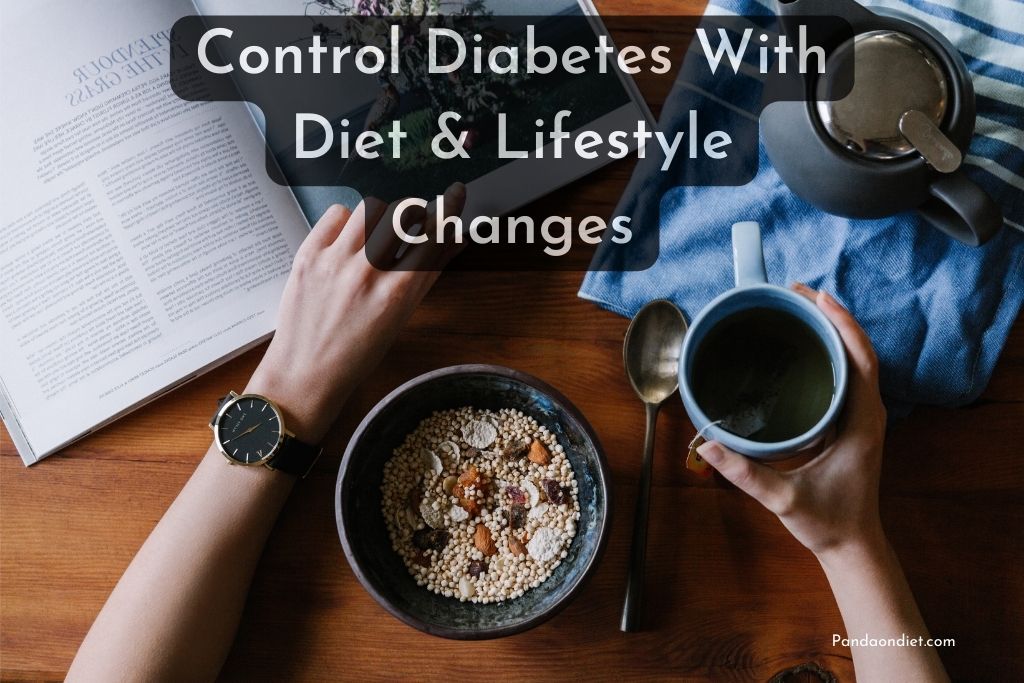Adopting a balanced diet and changing lifestyles are inseparable. Both are very important in managing diabetes. Type 2 diabetes, as you all know, is basically due to having bad living standards. So, I hope this article will be worth your read.
Firstly, you all have to know what lifestyle is. I know you are all aware of this term. However, let’s just revise this term. Lifestyle is how a person lives. It includes all your eating habits, sleeping, exercising, working, choices, and preferences. It’s just in their hand to make their lifestyle healthy or unhealthy.
Now you all are curious why I’m writing about this. So let me clear it up. Lifestyle and diabetes, more specifically type 2 leading cause of death around the world, diabetes are interrelated. Any lifestyle flaw or disturbance can lead to type 2 diabetes. It is better to adopt healthy eating practices.
Diet Management
Diabetes can not prevent you from eating food. It just makes you limit eating. Adopting healthy eating practices is very important. In this era of fast food, everybody unthinkingly eats and fills their bodies with junk. I’m not saying not to eat them, but you can limit them.
Instead of eating fast food 3,4 times a week. Limit your intake to 1 day per week. It helps you to satisfy your cravings and prevents you from overfilling.
Balanced and healthy food is the basis of healthy living for everyone. People with diabetes can check the foods that raise their blood glucose levels. Amount and type of food are important factors in determining which food does not cause a spike in blood sugar level.
Best Diet For Diabetics To Take

Carbohydrates and Low GI Foods
The myth people say about carbs is that it causes a spike in sugar levels rather than lowers them. Carbs are essential in the diet; they provide energy for proper body functioning.
It should be kept in mind while including carbs as their GI value. Higher GI food should be avoided. Includes low GI carbs like green vegetables, fruits, sweet potato, broccoli, tomato, and many more. Also, adjust your insulin, if you are taking it, before eating any meal.
Portion Size
Adjust your portion size of meals. Better to adjust your carbs amount. Do not include all carbs in one meal; divide carbs into 3 meals to prevent overfilling and a spike in sugar level.
Fruits and Vegetables
Include 3-5 servings of fruits and vegetables in your diet. Fruits and vegetables are rich in natural antioxidants that help the body in fighting against type 2 diabetes. Be wise in choosing, including those fruits and vegetables that are low GI.
Read: What Fruits Can A Diabetic Eat?
Refined Sugars
Avoid refined sugars, as these increase your blood sugar level abruptly.
Whole grains
Add a portion of whole grains to your meal. About 20-35 g per day is included in the diet. Whole grains are low in calories and have higher nutrient density. It provides dietary fibres that are very important for managing diabetes. It helps in treating constipation and lowers cholesterol levels. Soluble fibre helps in reducing serum lipids levels in the body.
Read: Can Diabetics Eat Whole Wheat Flour
Fats
Includes healthy fats like omega 3 and 6 in the diet. Add 2-3 oz of fish per week. You can also add olive oils, nuts, flax seeds, chia seeds, and walnuts to fulfil the fat requirements of the body. Limit your intake of trans and saturated fats. These are unhealthy fats and increase LDL levels in the body.
Proteins
Choose lean protein sources that help in making and repairing muscle mass. Avoid protein for diabetic nephropathy patients.
Read: Can Diabetic Drink Protein Shakes?
Salts
Better to consume less than 1500 mg per day of salts. Higher amounts cause an increased risk of hypertension that worsen diabetes.
Alcohols
Avoid alcohol; if not, then limit the alcohol to 2 drinks per day as it makes diabetes more complicated.
Processed Foods
Better to avoid them as they are higher in sugar and make your diabetes worse. Processed foods like sodas, fizzy drinks, packed snacks, etc. They are low in fibre, high in sugars, and cause spikes in sugar levels.
Read: Best Foods For Diabetics
Type 2 – Non-Insulin Dependent Diabetes Can Often Be Reversed With Diet And Lifestyle Changes
Exercise is the most important factor in managing diabetes. It’s good to say it is easier than you think. Being physically active has positive associations with preventing and treating diabetes.
Being active makes your body more insulin sensitive. It helps the cells in receiving more glucose from the blood cells. It is also important in improving your heart risk and controlling glucose levels.
Benefits of Being Physically Active

Many benefits of being physically active help you to achieve perfect glucose levels. Other benefits include are:
- Helps in losing weight
- Make you happier and more agile
- Cells become more insulin sensitive
- Helps in lowering blood pressure
- Makes you physically and mentally active
- Helps in improving insulin resistance
- Maintain healthy blood sugar level
Setting Goal
It is good to set the goal to remain healthy. Remember, along with modifying diet, and it is very important to do physical activity to keep your cell more sensitive to insulin.
- People with diabetes should also do moderately intense aerobic exercise 3 days per week out of a total of 150 min per week.
- Exercise should combine aerobic, muscle strengthening, and resistance exercises. Combination exercise helps in achieving better and faster results.
- Good to start with small steps. Like taking steps of stairs, walking around your garden, etc.
- The goal should be realistic and specific. Set your daily or weekly goal and try to achieve it, like walking a mile every day a month.
Some Moderate to Intense Exercise
Here is the list of some moderate to intense exercises:
- Brisk Walking
- Running
- Jogging
- Dancing
- Bicycling
- Swimming
- Playing some sports
Read: How Can A Diabetic Lose Weight
All individuals with diabetes should participate in an exercise program that combines resistance, flexibility, and balance training. Because the effects of exercise-induced changes in insulin action are transient, aerobic and resistance exercise should be done at least thrice weekly.
According to current recommendations, aerobic exercise should be performed 3–7 days a week, no more frequently than every two days. It is ideal to undertake resistance training 2-3 days each week, but never on consecutive days.
What Are The Factors That Make It Hard For Individuals To Implement Diet And Lifestyle Changes
Several factors act as a hurdle for people, making it hard, and people need to achieve a healthy lifestyle.
- Lack of motivation
- Fatigue
- Low self-esteem
- Busy Work Schedule
- Lack of self-management skills
- Fear of hypoglycemia
- Lack of facilities like parks, bicycles, etc
Sleep and Diabetes
Disturbance in the sleep cycle is common nowadays. Many studies have shown that irregular sleep causes insulin resistance and glucose intolerance in a normal person. It is quite dangerous for people with diabetes. Too little and irregular sleep causes insulin resistance and makes you hungry more.
Continuous sleep deprivation has been linked to glucose intolerance (difficulty metabolising glucose) and insulin resistance (insulin not acting properly), raising blood sugar levels.
This impact on the balance of blood glucose levels (glycaemic control) can practically increase someone’s risk of getting type 2 diabetes and make it harder for people with the disease to maintain their condition. So, get your sleep properly.
FAQs:
Is modifying diet really helpful?
Yes! By modifying their diet, people with diabetes can improve their sugar levels. Diet plays a crucial role in controlling diabetes. A single diet can improve your blood sugar level and insulin sensitivity.
Which type of Carbs are essential?
It’s good to add lower GI carbs to your diet. It provides early satiety and improves your sugar level in healthy ranges. Low GI food includes Apple, Dried apricots, Under-ripe bananas, Peaches, Strawberries, Oranges, Cherries, Coconut, Cranberries, Blueberries,
Pears, Plums, and Grapefruit.
Is exercise helpful in managing T2D?
Of course! Exercise plays a very important role in managing diabetes. It improves your blood sugar level, helps cells improve insulin sensitivity, and prevents other heart-related diseases.
How to overcome difficulties in sticking to a goal of achieving a healthy lifestyle?
Firstly, you have to make up your mind. That’s very important. Change your attitudes and behaviour towards eating habits. Make up your mind to do exercise. Start with little steps, then proceed towards more beneficial goals.
Final Words:
Diet and lifestyle modification plays a vital role in managing and controlling diabetes. Limit your eating, and do not overfill yourself. Includes healthy foods like fruits, vegetables, and dietary fibres to help manage type 2 diabetes. Losing weight and doing proper physical activity helps in improving your sugar levels. By adopting these healthy measures,s you can improve your overall health.
Related Articles:

